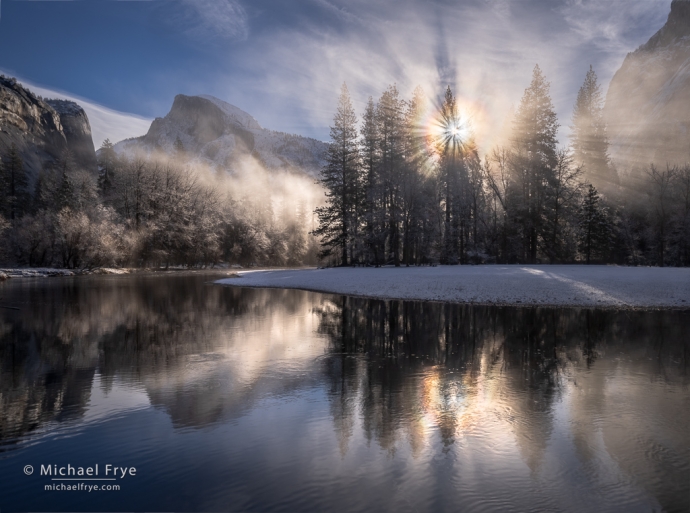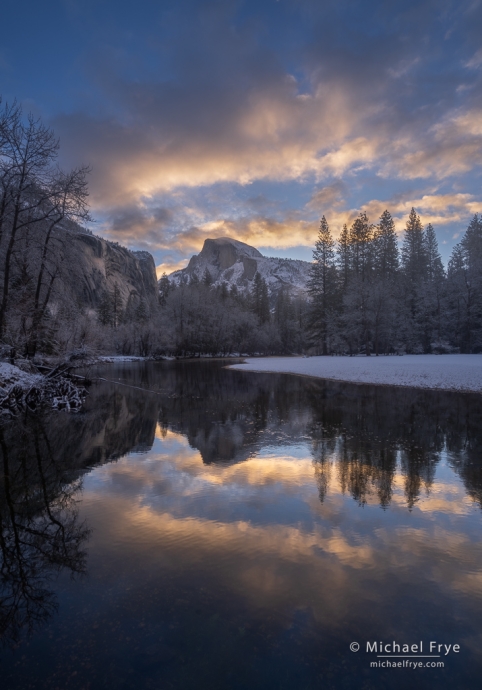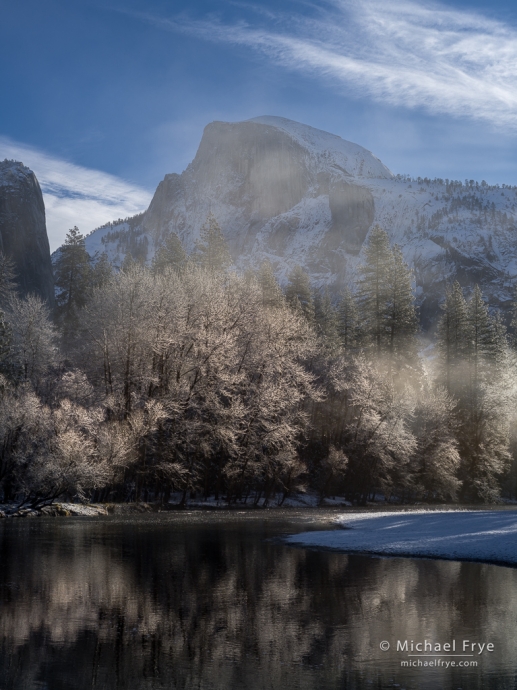I’ve felt like a hamster on a wheel lately, running nonstop just to keep up with the most essential tasks. But I finally have a moment to breathe, and time to write a blog post!
I made the photographs here in mid-February, after a weak storm moved through the Sierra. In a common pattern, it rained in Yosemite Valley during most of the storm, but the temperature dropped at the tail-end, leaving a dusting of new snow. At least that’s what I saw on the webcams early that morning. But when I arrived in the west end of the valley at first light, I didn’t find any new snow. Could it have snowed in the east end of the valley (where the webcams are), but not the west end? Sure enough, that’s what happened. The east end of the valley is slightly higher in elevation than the west end, and sometimes that’s enough to create a dusting of snow in the east end while the west end gets only rain.
In Yosemite Valley, I’ll take fog and mist over snow any day. But there wasn’t much mist anywhere that morning at first, so I thought, well, at least there’s new snow in the east end, so I’ll concentrate there.
I headed to a favorite spot along the Merced River, where bands of high clouds turned color at sunrise and reflected in the water. (See the first photo below.)
Then I was faced with the age-old question: should I stay or should I go? On the one hand, there wasn’t much mist where I was. On the other hand, there wasn’t much mist anywhere else, and no snow further west. I thought sunlight could generate some evaporation mist when it hit the trees where I was, so I decided to stay.
I’m glad I did, because that’s exactly what happened. Even though the moisture on the ground and in the trees was frozen, in the form of snow, the air temperature hovered right around freezing, and it didn’t take long for the sun to warm things enough to generate evaporation mist. It was just a little mist at first, but it kept building, until I saw full-blown sunbeams, a corona around the sun, and the whole backlit-mist light show.
Then, suddenly, the mist dissipated, and the show was over. But it was fun while it lasted.
Soon after that day we headed to Death Valley, where mist is decidedly rare. But we did find some “desert mist” (blowing dust), and lots of other interesting things to photograph. I’ll post some of those photos when I have a chance…
— Michael Frye
Related Posts: Half Dome and Fog; Should I Stay or Should I Go?
Michael Frye is a professional photographer specializing in landscapes and nature. He lives near Yosemite National Park in California, but travels extensively to photograph natural landscapes in the American West and throughout the world.
Michael uses light, weather, and design to make photographs that capture the mood of the landscape, and convey the beauty, power, and mystery of nature. His work has received numerous awards, and appeared in publications around the world. He’s the author and/or principal photographer of several books, including Digital Landscape Photography: In the Footsteps of Ansel Adams and the Great Masters, and The Photographer’s Guide to Yosemite.
Michael loves to share his knowledge of photography through articles, books, workshops, online courses, and his blog. He’s taught over 200 workshops focused on landscape photography, night photography, digital image processing, and printing.












Beautiful shots!!!
Thanks James!
Wonderful capture!
Thank you Terry!
Thank you for sharing Yosemite’s beauty! I can never get enough of it.
Thanks very much Pamela!
Wonderful image, Michael!
Thanks so much Bill!
That is abeautiful image that I could look at for looong time! Thank you!
Thanks very much Gail!